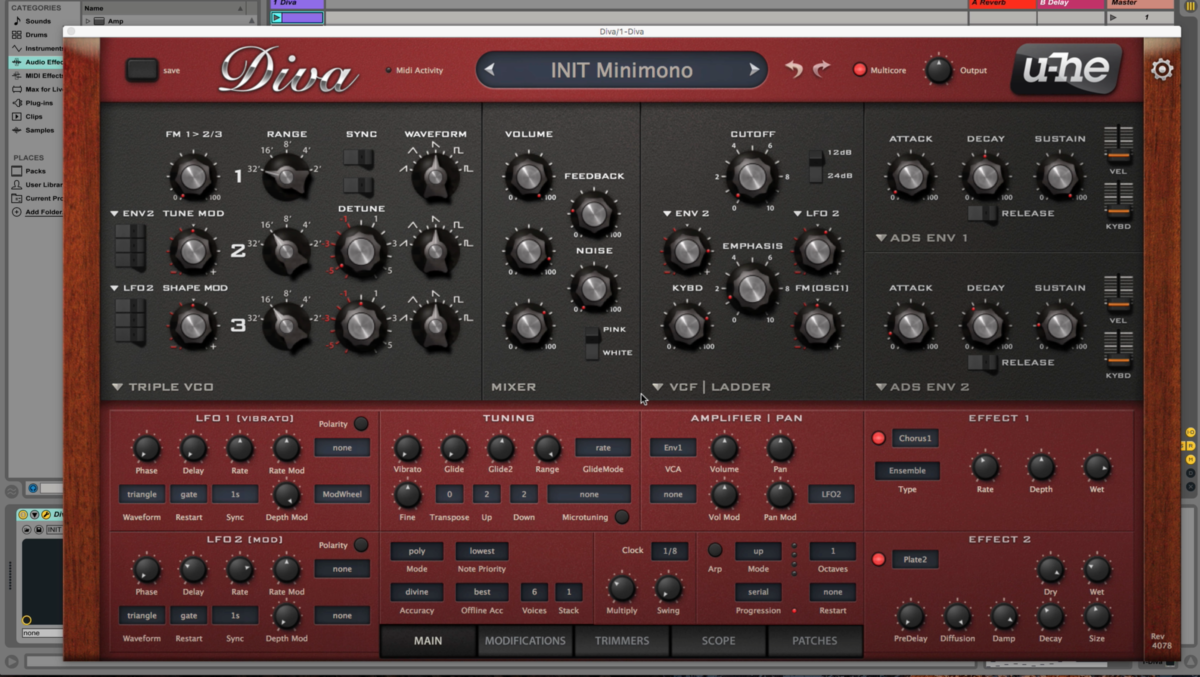

To be honest, I didn’t think it would be an issue on my multicore Mac Mini. u-he is quite up-front about this on their website and in throughout the user manual. You can then retune or transpose each voice in the stack up or down as much as two octaves to create ultra-thick leads or one-finger chords.Īll of this power comes at a price, and Diva can be pretty demanding in terms of CPU usage. And if that’s not vintage enough for you, the variance controls let you dial in additional randomness to filter cutoff, envelope time, pulse width or glide.Īnd for those of you who occasionally feel three oscillators is not enough for the lead sound you have in mind, the Stack option lets you stack up to six voices on one key for up to 18 oscillators on a single note. The Voice Map Modulator lets you map per-voice variations to other destinations as well, like filter or panning. Here you can use Oscillator Voice Detune to adjust the tuning of each oscillator in each voice, simulating the unique variations among individual voice chips in a polyphonic synthesizer. The Trimmers panel is a real treat for analogue afficionados. You can multiply or add signals together, quantize them to create stepped signals from smooth, or apply lag to smooth out square corners. Clicking the Modifications tab reveals even more modulation routing options, including virtual CV processing functions that allow you to manipulate control sources in a variety of useful ways. Regardless of the configuration you choose in the upper half of the panel, all patches can make use of the controls and modulation sources in the bottom half, including two LFOs, two effects processors, and an arpeggiator.

I found the scope very helpful when I was getting a handle on the digital oscillator in particular, which offers different wrapping, shaping and feedback controls, in addition to the much sought-after “super saw” waveform. Diva includes an oscilloscope to help you see exactly how they differ (I wonder if a certain hardware manufacturer didn’t take a cue from that design feature a few years ago). The oscillators provide a great deal of variety as well, and are each distinctive in their own way. I particularly enjoyed driving the Uhbie filter into self-oscillation – at its furthest extremes the resonance had a very convincing edge of chaos and unpredictability, just as you’d expect from the real thing.

My first stop in judging an analogue emulation is the filter, and Diva offers everything from creamy smooth ladder filters to multimode and state variable options. u-he credits “realtime circuit simulation” and “zero delay feedback design” for the sound quality, which gives a non-engineer like me only the vaguest sense of what they’re up to. Speaking as someone who grew up on subtractive synthesis, the sounds that Diva produces are exceptionally true to their hardware origins. For added authenticity, the Dual VCO and Bite VCF modules allow you to select different hardware revision options, each with their own distinct sonic character. This flexibility also extends to a total of five oscillator modules (including VCO, DCO and digital oscillator emulations), three high pass filters (plus a feedback only circuit in this slot), five low pass filters (including a multimode filter) and three envelope types to choose from. At its very simplest, you could create a faithful rendition of your favourite Minimoog patch, but if you feel limited by the original ADR envelope generators, you can swap out either (or both) for the ADSR version. Together, the range of options spans from the analogue monosynths of the early 70s to digital modelling synths of the late 90s. The design and sound of these components are inspired by real-world hardware synthesizers which, while not named, are easy enough to guess (particularly if you take a peek in the Templates folder, which includes names like “Jupe-8” and “Minimono”). oscillators, filters, and envelope generators, all have a variety of flavours to choose from.
#U HE DIVA MULTI CORE PATCH#
There are no patch cables to contend with, but the primary components, i.e. Diva’s novel approach to analogue emulation draws on a quasi-modular approach.


 0 kommentar(er)
0 kommentar(er)
